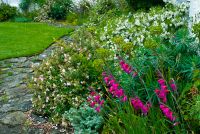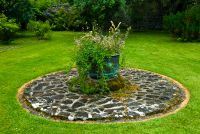
A 20-acre rhododendron garden surrounds historic Colonsay House manor, on the island of Colonsay. The gardens are considered one of the finest in Scotland. Aside from rhododendrons, the gardens feature a mix of trees and shrubs, many from the southern hemisphere.
Colonsay House Garden was planted primarily during the 1930s and consists of a formal garden area close to the Georgian manor house, and more informal woodland areas further from the house.
The most intriguing historical feature of the gardens is a small early Christian statue known as the Tobar Oran Sculptured Stone, believed to have been carved in the late 7th or early 8th century.
This curious statue stands immediately to the left of the garden entrance, beside a small pool dedicated to St Oran. The statue is in the shape of a cross, with a head of Christ at the top and a fishtail at the bottom. It was found near the ruins of the old chapel at Riasg Buidhe, a deserted village a few miles distant.
The formal garden includes mixed borders, clematis, climbing roses, and agapanthus, in addition to a small 'lighthouse' garden. The mild climate of Colonsay allows tender and exotic plants to flourish, including acacia, eucalyptus, myrtle, and magnolias. There is also a tree planted by King Edward VII and Queen Alexandra during a 1902 visit to Colonsay.
The woodland garden is open daily throughout the year, but the formal gardens are open only on Wednesday and Saturday during the summer months.
I loved visiting the gardens. A brief spring shower left sparkling drops of rain on the rhododendron blossoms and made the foliage shimmer with sparkling lights. This is a lush, magical place, and the backdrop of the historic manor house adds to the ambience.
About Colonsay House Gardens
Address: Colonsay House,
Kiloran,
Isle of Colonsay,
Argyll and Bute,
Scotland, PA61 7YU
Attraction Type: Garden
Location: In the grounds of Colonsay House, on a minor road 4 miles northwest of Scalasaig
Website: Colonsay House Gardens
Location
map
OS: NR392967
Photo Credit: David Ross and Britain Express
HERITAGE
 We've 'tagged' this attraction information to help you find related historic attractions and learn more about major time periods mentioned.
We've 'tagged' this attraction information to help you find related historic attractions and learn more about major time periods mentioned.
Historic Time Periods:
Find other attractions tagged with:
8th century (Time Period) - Edward VII (Person) - Georgian (Time Period) -
NEARBY HISTORIC ATTRACTIONS
Heritage Rated from 1- 5 (low to exceptional) on historic interest
Tobar Oran Sculptured Stone - 0 miles (Prehistoric Site) ![]()
Kiloran Bay Beach - 0.9 miles (Countryside) ![]()
St Columba's Well - 1.4 miles (Prehistoric Site) ![]()
Buaile Riabhach Stone Circle - 1.5 miles (Prehistoric Site) ![]()
Scalasaig Parish Church - 1.6 miles (Historic Church) ![]()
Dun Eibhinn Fort - 1.7 miles (Castle) ![]()
Lord Colonsay Monument - 1.8 miles (Historic Building) ![]()
Colonsay Whale Sculpture - 1.9 miles (Countryside) ![]()
Nearest Holiday Cottages to Colonsay House Gardens:
Nearby accommodation is calculated 'as the crow flies' from Colonsay House Gardens. 'Nearest' may involve a long drive up and down glens or, if you are near the coast, may include a ferry ride! Please check the property map to make sure the location is right for you.
Lochgilphead, Strathclyde
Sleeps: 4
Stay from: £405 - 686
Kilmartin, Strathclyde
Sleeps: 4
Stay from: £393 - 2160
More self catering near Colonsay House Gardens















